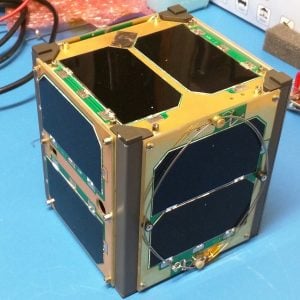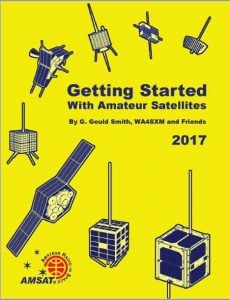Introduction
RadFxSat (Fox-1B) is scheduled for launch on November 18, 2017. RadFxSat is one of four CubeSats making up the NASA ELaNa XIV mission, riding as secondary payloads aboard the Joint Polar Satellite System (JPSS)-1 mission. JPSS-1 will launch on a Delta II from Vandenberg Air Force Base, California.

RadFxSat is a partnership with Vanderbilt University ISDE and hosts four payloads for the study of radiation effects on commercial off the shelf components. RadFxSat features the Fox-1 style FM U/v repeater with an uplink on 435.250 MHz (67.0 Hz CTCSS) and a downlink on 145.960 MHz. Satellite and experiment telemetry will be downlinked via the “DUV” subaudible telemetry stream and can be decoded with the FoxTelem software.

Launch and Early Orbit Phase (LEOP)
RadFxSat will launch at 01:47 PST (09:47 UTC) on November 18, 2017 from Vandenberg Air Force Base, California. Prelaunch Keplerian elements, which may not be accurate after a few orbits, are as follows:
RadFxSat
1 00000U 17017A 17322.46018518 -.00000000 00000-0 00000-0 0 9995
2 00000 97.6969 254.4977 0258300 235.3028 178.8186 14.79656332 -137 06
The estimated time of “First Veronica,” the initial beacon after deployment, is 12:07 UTC. Due to the tight constraints on the primary payload deployment, the secondary payloads may be delayed slightly, so this should be considered the soonest the transmitter will be enabled. Updated orbital elements will be published as soon as they are available on the AMSAT website.
Participation in telemetry collection by as many stations in as many parts of the world as possible is essential as AMSAT Engineering looks for successful startup and indications of the general health and function of the satellite as it begins to acclimate to space. The first amateur radio operator that successfully receives RadFxSat (Fox-1B) telemetry and uploads it to the AMSAT server will receive a commemorative 3D printed QSL card.
If you are capturing telemetry with FoxTelem please be sure that “Upload to Server” is checked in your settings, and that your “Ground Station Params” are filled in as well. You can help AMSAT and everyone waiting to get on the air with RadFxSat tremendously by capturing RadFxSat telemetry.
About 60 minutes after deployment, or 140 minutes after launch, the satellite will start up in Beacon Mode. In this initial mode, the transmitter is limited to 10 seconds on time and then will be off for two minutes. For those of you capturing telemetry, that means that you will only see Current frames and no High or Low frames. The High and Low frames are truncated as it takes just over the 10 second limit to send two frames. Veronica may also be cut off before she gets to say her whole ID string as the full ID, “RadFxSat Fox-1B Safe Mode,” is a bit longer than the approximately 3.5 seconds she has in Beacon Mode. If the voice ID is cut off, the satellite is still in Beacon Mode.
If AMSAT Engineering is seeing nominal values from the telemetry you gather, the satellite will be commanded from Beacon Mode to Safe Mode on the first good pass over the United States. In Safe Mode, the satellite transmits a full two frames of telemetry (one Current frame followed by, and alternating each ID cycle, a High or a Low frame). Veronica now has time to make the whole ID announcement in Safe Mode.
The on-orbit checkout procedure for RadFxSat is similar to Fox-1A/AO-85 and could be completed in as little as a few days if users cooperate. It is very important, and good amateur operating practice, to refrain from using the transponder uplink so the on-orbit tests can be performed, including when the satellite is switched into Transponder Mode for testing.
AMSAT will make it broadly known when the tests are complete and the transponder is available for all to use. If you hear someone on the transponder, please do not assume that it is open for general use – check AMSAT’s website, Facebook, and Twitter before transmitting to be sure you do not interfere with testing.
AMSAT asks all satellite operators to contribute just a little bit of your time by gathering telemetry, not using the transponder uplink, to help complete the last few days of getting RadFxSat operating for the amateur radio community.
Lots of hams put thousands of volunteer hours of their time into making RadFxSat happen. Just like any ham radio project you might undertake, AMSAT builds satellites. AMSAT volunteers do it because they like to, and when they are done, AMSAT freely shares their project with hams everywhere as is the spirit of amateur radio.
Thank you very much and see you on the bird!
Radio Programming Chart
| RadFxSat (Fox-1B) Doppler Shift Correction | ||
| Memory | Your Transmit Frequency
(With 67 Hz Tone) |
Your Receive Frequency |
| Acquisition of Signal (AOS) | 435.240 MHz | 145.960 MHz |
| Approaching | 435.245 MHz | 145.960 MHz |
| Time of Closest Approach (TCA) | 435.250 MHz | 145.960 MHz |
| Departing | 435.255 MHz | 145.960 MHz |
| Loss of Signal (LOS) | 435.260 MHz | 145.960 MHz |
Frequencies are subject to change after launch.
Special Membership Offer
As part of the preparations for the launch of RadFxSat, AMSAT is making the “Getting Started With Amateur Satellites” book available for a limited time as a download with any paid new or renewal membership purchased via the AMSAT Store. This offer is only available with purchases completed online, and for only a limited time. A perennial favorite, Getting Started is updated every year with the latest amateur satellite information, and is the premier primer of satellite operation. The 182 page book is presented in PDF format, in full color, and covers all aspects of making your first contacts on a ham radio satellite.

Please take advantage of this offer today by visiting the AMSAT store at https://www.amsat.org/shop/ and selecting any membership option. While there, check out AMSAT’s other items, including the M2 LEOpack antenna system, Arrow antennas, AMSAT shirts, and other swag. Be sure to view your cart before going to checkout. If you add a membership and then go directly to checkout, you’ll never see an option to add your free gift.
